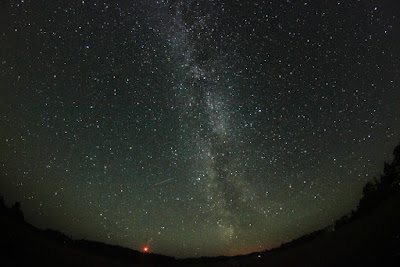 |
| Note the velocity Relative to Pluto (km/s): 13.78. Credit: NASA JAPL. New Horizons mission to Pluto |
Everybody is baffled by the New Horizons mission to Pluto.
It got me thinking and with the help from my mom i know now that the spacecraft that passed the Pluto system is going roughly 74,000 km/h. At this time, the spacecraft is traveling at 13.78 km/s relative to Pluto.
This is straight from Wikipedia, Ladies and Gentlemen.
After three years of construction, and several delays at the launch site,
New Horizons was launched on January 19, 2006, from
Cape Canaveral, directly into an
Earth-and-solar-escape trajectory with an Earth-relative speed of about 16.26 kilometers per second (58,536 km/h; 36,373 mph); it set the record for the highest launch speed of a human-made object from
Earth.
After a brief encounter with asteroid
132524 APL,
New Horizons proceeded to
Jupiter, making its closest approach on February 28, 2007 at a distance of 2.3 million kilometers (1.4 million miles). The Jupiter flyby provided a
gravity assist that increased
New Horizons ' speed by 4 km/s (14,000 km/h; 9,000 mph). The encounter was also used as a general test of
New Horizons ' scientific capabilities, returning data about
its atmosphere,
moons, and
magnetosphere. Most of the post-Jupiter voyage was spent in hibernation mode to preserve on-board systems, except for brief annual checkouts.
[5] On December 6, 2014,
New Horizons was brought back online for the encounter, and instrument check-out began.
[6] On January 15, 2015, the
New Horizons spacecraft began its approach phase to Pluto. On July 14, 2015 11:49
UTC (07:49 EDT), it flew 12,600 km (7,800 mi) above the surface of Pluto,
[7][8] making it the first spacecraft to explore Pluto.
[4][9] Hours later, at 00:52:37 UTC (20:52:37 EDT),
[10] NASA received the first communication from the probe following flyby at the time expected. Engineering data indicated that the flyby was successful and the probe operated in all respects as expected.
[11][12][13]
So lets see now! The Moon is at a 385,000 km from Earth.
The spacecraft is traveling at 60,000 km/h initially.
The Jupiter push increased the velocity by 4km/s. (14,000 km/h)
60,000 km/h + 14,000 km/h = 74,000 km/h
385,000 km % 74,000 km / gives us the hours it takes to make that distance (in hours).
385 % 60 = 5.20 hours.
So this means the New Horizons spacecraft every 5 hours and some minutes he makes the distance between Earth and the Moon.
Now at roughly 74,000 km/h "Where is he going?" my mom asked me. I frankly don't know the answer to that question, but surely to new horizons.
https://en.wikipedia.org/wiki/New_Horizons
https://en.wikipedia.org/wiki/Moon
http://pluto.jhuapl.edu/
Read more about Astronomy Club Toutatis, Kustavi, Finland.


















































